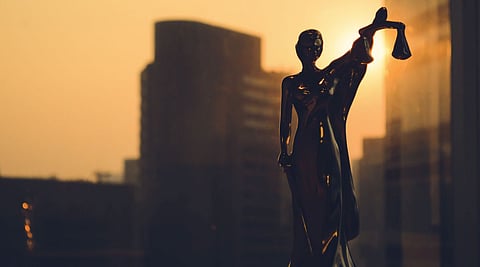

The retirement of Justice Indu Malhotra from the Supreme Court has precipitated talk about gender equality in the judiciary. Unfortunately, little of that can be seen as there is only one woman judge left in the apex court and just 81 in the High Courts. Will this be reversed, asks NEERAJ MISHRA.
—–
AS of today, there are only 81 female judges in the country's High Courts against 1,078 male judges. In the Supreme Court, it is even less with the recent retirement of Justice Indu Malhotra. Now Justice Indira Banerjee is the only female judge against 29 male ones. The figures are starker when compared to the US where the percentage of female judges is from 27 to 34.
The Indian Supreme Court, which got its first female judge only in 1989 and has never had a woman chief justice in nearly 75 years of its existence, continues to be bereft of even a sliver of respect for such demographics.
India beats the US when it comes to universal franchise. Women acquired voting rights as a matter of rights with Independence and there has never been any legal attempt to outcast the lower castes from voting. In the US on the other hand, Blacks acquired voting rights only through the 1965 Voting Rights Act which allowed them to register freely for the first time. Today, things have moved so far ahead for Black women that the judiciary has an adequate representation of them at seven percent. In contrast, there is zero representation for the Scheduled Castes and Scheduled Tribes in India as affirmative action is missing in the judiciary.
Furthermore, a Dalit woman judge has as much chance of reaching the Supreme Court as Ganguram from Bastar has of having tea with the Queen at Buckingham Palace. From Justice Fathima Beevi in 1989 to Justice Banerjee, there have only been eight-woman judges in the apex court and none of them are from the marginalised sections or regions of the country.
Similarly in its long journey, the Supreme Court has had very few judges from the North-east, and never a woman. Only Justice Hrishikesh Roy is from the Gauhati High Court, while judges from Delhi and Bombay dominate the bench.
There has been some talk of promoting women to the apex court as five seats, including that of Chief Justice of India (CJI) S.A. Bobde, fall vacant this year. Some woman judges, including Justice B.V. Nagarathna of the Karnataka High Court, have been discussed by the Supreme Court collegium.
If elevated, Justice Nagarathna, who was appointed judge of the Karnataka High Court on February 2, 2008, could succeed Justice Surya Kant as the CJI in February 2027, and occupy the post till October 29, 2027. But there are several hurdles to her elevation. Her father, Justice E.S. Venkataramiah, was CJI for a few months in 1989, and the judiciary could attract the same allegations of continuing nepotism and being a closed circle. Another hurdle is that the Supreme Court already has three judges from the Karnataka High Court. None of them is slated to retire before January 2023.
Another female judge in the zone of consideration is Justice Bela Trivedi. But here, the Gujarat connection will follow her; she is No 3 in the Gujarat High Court and was sworn-in as a judge in February 2011. Prior to this, she served as a district judge for more than a decade and was also deputed as the law secretary in the Gujarat government then led by Narendra Modi. She was transferred to the Rajasthan High Court on June 27, 2011, due to her perceived proximity to the then government in the state, but was brought back to the Gujarat High Court in February 2016.
The first chief justice of the Telangana High Court, Justice Hima Kohli, also has a strong Delhi connection having been sworn in as an additional judge there in 2006. But she will retire in September this year, so it seems unlikely that she will be elevated. That should also bring into the zone of consideration women judges from the North-east.
In the three High Courts in that region, there are only two woman judges: Justice Rumi Kumari Phukan of the Gauhati High Court and Justice Meenakshi Madan Rai of the Sikkim High Court. Justice Phukan was elevated in 2011 and has a little over a year of her tenure left, while Justice Rai, elevated in 2015, will retire in 2026 and could remain a judge till 2029 if elevated. Both belong to the services background and have experience of the subordinate as well as higher judiciary. After the retirement of Justice Bhanumathi, there is no judge in the Supreme Court with similar experience.
Justice Rai graduated from Delhi University and has worked as a junior with Kailash Vasdev and Arun Jaitley in the late 1980s before joining the state judicial services. She may be this government's best chance to reverse some of the talk about affirmative action in judicial appointments and women's rights since there are no set parameters of seniority for elevation. She is a rare combination of a Dalit, north-easterner and woman with no filial links to the judiciary.
In a submission to the Supreme Court in December 2020, Attorney General KK Venugopal had noted that there was a need to balance the gender demographics in courtrooms, especially with respect to sexual offences. It has to begin at the top. While the BJP has been quick to claim ownership of state governments of the North-east having formed them with the help of local turncoats, it has not really done anything to promote people from the region. This may be its chance to overturn that perception.
(Neeraj Mishra is a senior journalist, farmer and lawyer based in Raipur, Chhattisgarh. The views expressed are personal.)